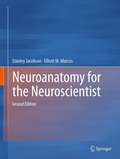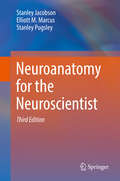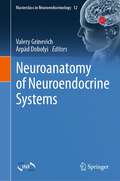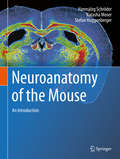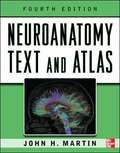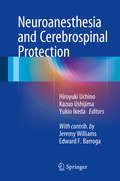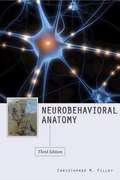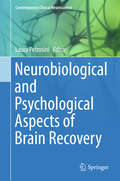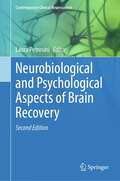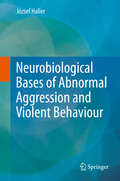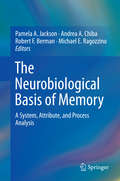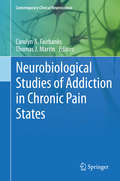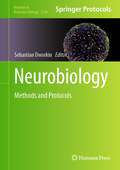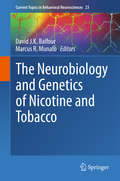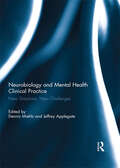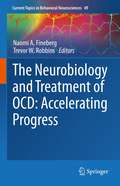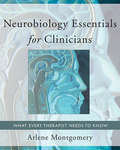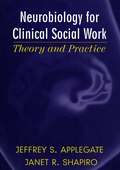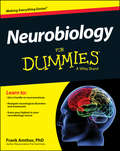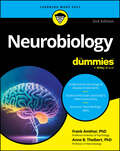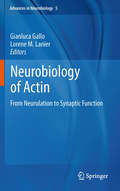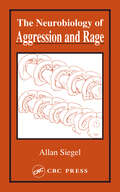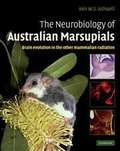- Table View
- List View
Neuroanatomy for the Neuroscientist
by Stanley Jacobson Elliott M. MarcusIn this day where research grants are the primary focus, many young investigators are thrown into neurosciences courses without any prior preparation in neuroanatomy. This book is designed to help prepare them by introducing many of the fundamentals of the nervous system. It represents the essentials of an upper level biology course on the central nervous system. It is not designed to be a clinical approach to the nervous system, but rather it approaches the nervous system from a basic science perspective that intertwines both structure and function as an organizing teaching and learning model. Medical and dental examples are included but the main focus is on neuroscience.
Neuroanatomy for the Neuroscientist
by Stanley Jacobson Elliott M. Marcus Stanley PugsleyThe purpose of this textbook is to enable a Neuroscientist to discuss the structure and functions of the brain at a level appropriate for students at many levels of study including undergraduate, graduate, dental or medical school level. It is truer in neurology than in any other system of medicine that a firm knowledge of basic science material, that is, the anatomy, physiology and pathology of the nervous system, enables one to readily arrive at the diagnosis of where the disease process is located and to apply their knowledge at solving problems in clinical situations. The authors have a long experience in teaching neuroscience courses at the first or second year level to medical and dental students and to residents in which clinical information and clinical problem solving are integral to the course.
Neuroanatomy of Neuroendocrine Systems (Masterclass in Neuroendocrinology #12)
by Valery Grinevich Árpád DobolyiIn this book, experts in the field provide comprehensive descriptions of the neuroanatomy of the hypothalamic neuroendocrine systems.The book begins with an extensive discussion on the structural components of the neuroendocrine systems. The reader will be introduced to the anatomy and biology of the hypothalamus and the pituitary. The human hypothalamus is presented in particular detail using state-of-the-art imaging techniques. In the next section, the neuroanatomy of traditional hypothalamo-hypophyseal systems is highlighted, with chapters describing magnocellular neuroendocrine cells and discussing the respective types of hypothalamic neurons that regulate various pituitary hormones. Following this detailed structural and anatomical description of the neuroendocrine system, the book’s final section focuses on the hypothalamic control of neuroendocrine functions. This includes the control of circadian rhythm, metabolism and appetite via specific peptidergic circuits.This book provides essential information on the neuroanatomy and control of neuroendocrine systems, addresses cutting-edge research questions posed by recent advances in the development of potent neuroanatomical tools, and highlights the latest technologies used in neuroendocrinology research, making it a valuable reference guide for students, trainees and established researchers alike. This is the twelfth volume in the International Neuroendocrine Federation (INF) Masterclass in Neuroendocrinology series, which aims to illustrate the highest standards and to encourage the use of the latest technologies in basic and clinical research and hopes to provide inspiration for further exploration into the exciting field of neuroendocrinology.
Neuroanatomy of the Mouse: An Introduction
by Stefan Huggenberger Natasha Moser Hannsjörg SchröderThis textbook describes the basic neuroanatomy of the laboratory mouse. The reader will be guided through the anatomy of the mouse nervous system with the help of abundant microphotographs and schemata. Learning objectives and summaries of key facts at the beginning of each chapter provide the reader with an overview on the most important information.As transgenic mice are one of the most widely used paradigms when it comes to modeling human diseases, a basic understanding of the neuroanatomy of the mouse is of considerable value for all students and researchers in the neurosciences and pharmacy, but also in human and veterinary medicine. Accordingly, the authors have included, whenever possible, comparisons of the murine and the human nervous system. The book is intended as a guide for all those who are about to embark on the structural, histochemical and functional phenotyping of the mouse’s central nervous system. It can serve as a practical handbook for students and early researchers, and as a reference book for neuroscience lectures and laboratories.
Neuroanatomy Text and Atlas (4th Edition)
by John H. MartinA regional and functional approach to learning human neuroanatomy <p><p> A Doody's Core Title for 2015!<p> Neuroanatomy:Text and Atlas covers neuroanatomy from both a functional and regional perspective to provide an understanding of how the components of the central nervous system work together to sense the world around us, regulate body systems, and produce behavior. This trusted text thoroughly covers the sensory, motor, and integrative skills of the brains and presents an overview of the function in relation to structure and the locations of the major pathways and neuronal integrative regions. <p> Neuroanatomy:Text and Atlas also teaches you how to interpret the new wealth of human brain images by developing an understanding of the anatomical localization of brain function. The authoritative core content of myelin-stained histological sections is enhanced by informative line illustrations, angiography, and brain views produced by MRI, and other imaging technologies. <p> NEW to this edition: <p> Revised and updated to reflect advances in clinical neuroanatomy and neural science<br> Full-color illustrations have been added to enrich the text<br> Chapters begin with a clinical case to illustrate the connections and functions of the key material<br> Chapters end with a series of multiple-choice review questions<br> <p>Features and Benefits: <p> Increases knowledge of the regional and functional organization of the spinal cord and brain, one system at a time<br> Provides thorough coverage of the sensory, motor, and integrative systems of the brain, together with cerebral vasculature<br> Promotes understanding of the complex details of neuroanatomy needed for accurate interpretation of radiological image<br> Comprehensive atlas provides key views of the surface anatomy of the central nervous systems and photographs of myelin-stained sections in three anatomical planes<br> Includes learning aids such as clinical topics, boxes, chapter summaries, and a Glossary of key terms and structures
Neuroanesthesia and Cerebrospinal Protection
by Hiroyuki Uchino Kazuo Ushijima Yukio IkedaThis book is a knowledge-based text that covers the anatomy, neurophysiology, and neuropharmacology needed to carry out the necessary management and cerebrospinal protection during neuroanesthesia. Especially to make the subject of neuroanesthesia more approachable, we introduce surgical measures utilized in neurosurgery, cardiovascular surgery, neuromodulation, and related procedures. The main purpose of neuroanesthesia/neurocritical care is to deliver cerebrospinal protection in neurosurgical and cardiovascular surgeries. How should we select the best anesthetic management to prevent neurological complications for patients who, for instance, undergo different types of surgery for subarachnoid hemorrhage, stroke, head trauma, carotid endarterectomy, or cardiovascular surgery under cardiopulmonary bypass? These pathological conditions include the risk of transient cerebrospinal ischemia, and if our management is not precise, it may induce serious neurological sequelae. Although there is an urgent need to establish the treatment and elucidate the molecular mechanisms of cerebrospinal injury, many components are intertwined, making this a challenge we have not completely solved yet. This volume makes the management of neuroanesthesia more accessible not only for primary residents but also for specialists, providing a valuable resource on the current perspectives of neuroanesthesia.
Neurobehavioral Anatomy, Third Edition
by Christopher M. FilleyThoroughly revised and updated to reflect key advances in behavioral neurology, Neurobehavioral Anatomy, Third Edition is a clinically based account of the neuroanatomy of human behavior centered on a consideration of behavioral dysfunction caused by disorders of the brain. A concise introduction to brain-behavior relationships that enhances patient care and assists medical students, the book also serves as a handy reference to researchers, neuroscientists, psychiatrists, and geriatricians. The book outlines how cognitive and emotional functions are represented and organized in the brain to produce the behaviors regarded as uniquely human. It reviews the effects of focal and diffuse brain lesions, and from this analysis a conception of the normal operations of the healthy brain emerges. Christopher M. Filley integrates data and material from different disciplines to create a concise and accessible synthesis that informs the clinical understanding of brain-behavior relationships. Clinically practical and theoretically stimulating, the book is an invaluable resource for those involved in the clinical care and study of people with neurobehavioral disorders. Including a useful glossary and extensive references guiding users to further research, the third edition will be of significance to medical students, residents, fellows, practicing physicians, and the general reader interested in neurology.
Neurobiological and Psychological Aspects of Brain Recovery
by Laura PetrosiniThe novelty of this book's approach lies in addressing the impact of neurobiological factors as well as psychological influences on brain recovery. There is growing evidence that emotional, motivational, and cognitive factors along with personality traits play a crucial role in brain plasticity, resilience, and recovery. Topics include synaptic and neuronal plasticity, development of brain reserves, biological markers, environmental factors, psychological profile, emotional resilience, and personality traits. By combining the latest research on neural mechanisms and on psychological resilience the authors hope that this book can lead to the development of better treatment strategies for functional recovery from brain damage.
Neurobiological and Psychological Aspects of Brain Recovery (Contemporary Clinical Neuroscience)
by Laura PetrosiniThe novelty of this book's approach lies in addressing the impact of neurobiological factors as well as psychological influences on brain recovery. There is growing evidence that emotional, motivational, and cognitive factors along with personality traits play a crucial role in brain plasticity, resilience, and recovery. Topics include synaptic and neuronal plasticity, development of brain reserves, biological markers, environmental factors, psychological profile, emotional resilience, and personality traits. By combining the latest research on neural mechanisms and on psychological resilience the authors hope that this book can lead to the development of better treatment strategies for functional recovery from brain damage.
Neurobiological and Psychological Aspects of Brain Recovery (Contemporary Clinical Neuroscience)
by Laura PetrosiniThe importance of this unique book's approach lies in addressing the impact of neurobiological factors as well as psychological influences on brain recovery following injury. There is growing evidence that emotional, motivational, and cognitive factors along with personality traits play a crucial role in brain plasticity, resilience, and recovery. Topics include synaptic and neuronal plasticity, development of brain reserves, biological markers, environmental factors, emotional resilience, and personality traits. By combining the latest research on neural mechanisms and psychological resilience the authors present a book that will help lead to the development of better treatment strategies for functional recovery from brain damage. The new edition is fully updated throughout and contains completely new chapters on brain recovery in childhood, epigenetic aspects of brain recovery, and artificial intelligence techniques in traumatic brain injury research.
Neurobiological Bases of Abnormal Aggression and Violent Behaviour
by József HallerMechanisms controlling aggressive behavior started to be identified from late 20's of the 20th century and subsequent research described such mechanisms in great detail. While the findings are of great relevance for the understanding of aggression per se, they provide limited insights into the mechanisms of abnormal aggression i. e. those mechanisms that underlie aggression-related psychopathologies. While basic phenomena and mechanism of aggression are presented, this book is the first that comprehensively describes ultimate and proximate mechanisms that transform normal (laboratory animals) or tolerable (humans) manifestations of aggressiveness into abnormal patterns in laboratory animals and aggression-related psychopathologies in humans. This book is written for behavioral neurobiologists and neuroscientists, interested in emotional control in general and aggression research in particular. The book will also offer important information to neurologists and psychiatrists dealing with aggressive behavior in the clinic and ultimately, may provide means to understand and on the long run to discover novel approaches to the treatment of abnormal human aggression.
The Neurobiological Basis of Memory
by Pamela A. Jackson Andrea A. Chiba Robert F. Berman Michael E. RagozzinoThis exciting volume offers an up-to-date tour of current trends in the neurobiology of memory while saluting Raymond Kesner's pioneering contributions to the field as a theorist and researcher, teacher and mentor. Starting with his signature chapter introducing the Attribute Model of Memory, the first half of the book focuses on the central role of the hippocampus in processing dimensions of space and time, and branches out to memory system interactions across brain structures. Later chapters apply the attribute model to multiple functions of memory in learning, and to specific neurological contexts, including Huntington's disease, traumatic brain injury, and Fragile X. As a bonus, the book concludes with an essay on Kesner's life and work, and reminiscences by colleagues. Among the topics covered: How the hippocampus supports the spatial and temporal attributes of memory. Self-regulation of memory processing centers of the brain. Multiple memory systems: the role of Kesner's Attribute Model in understanding the neurobiology of memory. Pattern separation: a key processing deficit associated with aging? · Prefrontal cortex and basal ganglia attributes underlying behavioral flexibility. Memory disruption following traumatic brain injury. Cognitive neuroscientists, neuropsychologists, gerontologists, psychiatrists, and neurobiologists will find The Neurobiological Basis of Memory both enlightening and inspiring--much like Kesner himself.
Neurobiological Basis of Migraine
by Michael A. Moskowitz Turgay DalkaraPublished with the New York Academy of Sciences A timely, broad-ranging exploration of the neurobiological basis and molecular mechanisms of migraines Migraines impact the lives of a significant portion of the world's population, afflicting sufferers with severe pain, nausea, and often visual impairment. The WHO views migraines as an important public health issue, and ranks them in its top twenty most disabling illnesses. Neurobiological Basis of Migraine reviews the latest advances made in our understanding of the primary basic mechanisms of migraine headache and provides valuable insights into how these findings are being translated into novel treatment and prevention strategies around the world. Written for researchers and clinicians alike, the book features edited contributions from distinguished experts in the field, taking a focused, yet wide-ranging approach to the subject. It begins by exploring the pathways and networks mediating migraine headaches, their underlying physiological mechanisms, characteristics of visceral pain, and the concept of dural neurogenic inflammation. From there the authors delve into the mechanisms sustaining the head pain and photophobia associated with migraines, and they review the pharmacology of newly discovered migraine treatments. These basic chapters are followed by clinical and genetic studies linking to key issues, including cortical spreading depression, ion channels, transporters, and epilepsy. Reviews of the latest advances in our understanding of the neurobiological basis of migraine Translates important research findings from around the globe into novel treatments strategies currently being investigated Provides researchers and clinicians with a deep understanding of the primary mechanisms of migraine from migraine modeling to clinical applications Includes contributions by many of the most respected researchers in the field, world-wide Discusses exciting recent developments in migraine mutations and their role in CSD, as well as the role of CSD in aura and trigeminal activation Timely, comprehensive, and authoritative, Neurobiological Basis of Migraine is an indispensable working resource for clinicians and migraine, headache, and pain researchers, including neurobiologists, neuropharmacologists, neurologists, and vascular neurobiologists, as well as graduate students in those fields who are involved in researching migraine headaches.
Neurobiological Studies of Addiction in Chronic Pain States
by Carolyn A. Fairbanks Thomas J. MartinUsing rodent models, this volume explores the basic neurobiology of the relationship among chronic pain, opioid pharmacology, and addiction.
Neurobiology: Methods and Protocols (Methods in Molecular Biology #2746)
by Sebastian DworkinThis volume will serve as a guide for students in the field of neurobiology, and be a bridge between basic science researchers, doctors, and surgeons in clinical practice. Written in the highly successful Methods in Molecular Biology series format, chapters include introductions to their respective topics, lists of the necessary materials and reagents, step-by-step, readily reproducible laboratory protocols, and tips on troubleshooting and avoiding known pitfalls.Authoritative and cutting-edge, Neurobiology: Methods and Protocols aims to ensure successful results in the further study of this vital field.
The Neurobiology and Genetics of Nicotine and Tobacco
by David J. K. Balfour Marcus R. MunafòThe primary purpose of this book and its companion volume The Neuropharmacology of Nicotine Dependence is to explore the ways in which recent studies on nicotine and its role in tobacco addiction have opened our eyes to the psychopharmacological properties of this unique and fascinating drug. While the present volume considers the molecular and genetic factors which influence behavioral responses to nicotine and how these may impact on the role of nicotine in tobacco dependence, the book The Neuropharmacology of Nicotine Dependence focuses on the complex neural and psychological mechanisms that mediate nicotine dependence in experimental animal models and their relationship to tobacco addiction in humans. These volumes will provide readers with a contemporary overview of current research on nicotine psychopharmacology and its role in tobacco dependence from leaders in this field of research and will hopefully prove valuable to those who are developing their own research programmes in this important topic.
Neurobiology and Mental Health Clinical Practice: New Directions, New Challenges
by Dennis Miehls and Jeffrey ApplegateThis book illustrates the current findings of interpersonal neurobiology that inform knowledge building and clinical practice. Contributions cover an impressive range of material including how neurobiology interfaces with clinical work with children, individuals with substance abuse issues, couples and clients with trauma histories. Leading mental health clinician-scholars describe path-breaking explorations at the neurobiological frontiers of 21st century clinical theory and practice. Representing the fields of social work, psychology and psychiatry, these authors creatively apply research findings from the ongoing revolution in social and behaviour neuroscience to a diverse array of clinical issues. Contributions include elaborations of theory (the evolving social brain; new directions in attachment, affect regulation and trauma studies); practice (neurobiologically informed work with children, adults, couples and in the conduct of supervision); and emerging neuroscientific perspectives on broader mental health issues and concerns (substance abuse; psychotropic medications; secondary traumatic stress in clinicians; the neurodynamics of racial prejudice; the dangers of forfeiting humanism to our current romance with the biological). Together, these chapters equip readers with state-of-the-art knowledge of the manner in which new understandings of the brain inform and shape today’s professional efforts to heal the troubled mind. This book was originally published as a special issue of Smith College Studies in Social Work.
The Neurobiology and Treatment of OCD: Accelerating Progress (Current Topics in Behavioral Neurosciences #49)
by Naomi A. Fineberg Trevor W. RobbinsThe book highlights important new research approaches of clinical relevance, written by prominent researchers in the field of OCD and related disorders. A broad range of topics is covered, beginning with a description of the phenotypic features of the OCD followed by chapters on developmental aspects, animal models, genetic and biological models including neuro-inflammation, functional neuroimaging correlates and information-processing accounts. Finally, existing and novel treatment approaches are covered including clinical and pharmacogenetic treatment models. In this way the volume brings together the key disciplines involved in the neurobiological understanding of OCD to provide an update of the field and outlook to the future. Together, the volume chapters provide focused and critical reviews that span a broad range of topics suitable for both students and established investigators and clinicians interested in the present state of OCD research.
Neurobiology Essentials for Clinicians: What Every Therapist Needs to Know
by Allan N. Schore Arlene MontgomeryThis book presents an overview of the latest theories of affect regulation and focuses on how these theories work in clinical settings and how therapists can be taught to implement them. The notion of teaching and learning will be extended by the theories themselves-the author presents methods of education that enact the theories being taught. The book is divided into eight chapters, each one highlighting a particular structure or related structures of the brain. Suggestions for learning how to clinically apply the neurobiological/neuroanatomical information are offered. What is so unique about this book is that the bulk of the chapters are clinical dialogue, accompanied by neurobiological commentary. Thus, readers can see for themselves, during the course of parts of sessions, just how a "neurobiological outlook" can inform therapeutic understandings of what clients are doing and saying. The result is a very user-friendly learning experience for readers, as they are taken along a journey of understanding various brain systems and how they relate to psychotherapeutic principles. Elegantly bridging the gap between the academic and clinical domains, this book is essential for anyone interested in the application of neurobiological principles to psychotherapy and wishes to learn about neurobiology without feeling overwhelmed or intimidated.
Neurobiology for Clinical Social Work: Theory and Practice (Norton Series on Interpersonal Neurobiology)
by Jeffrey S. Applegate Janet R. ShapiroThe last fifteen years have produced an explosion of research on the neurobiology of attachment. This research, which explores the ways in which affect regulation play key roles in determining the structure and function of the developing brain and mind, has led to a revolution in the way that parent-child relationships are viewed. Although these insights have informed psychiatry as well as cognitive and psychoanalytic psychology, their application to social work practice, education, and research has been lacking. Here for the first time ever, social work educators Jeffrey Applegate and Janet Shapiro demystify neurobiology and present it anew with the social work audience specifically in mind. Social workers, by virtue of their work with at-risk children and families, occupy a unique position from which to employ this new research in prevention and intervention. This lack of education about neurobiology has unfortunately fostered misconceptions among social workers that these theories are too academic and thus irrelevant to clinical practice. Neurobiology for Clinical Social Work corrects this misconception and introduces social workers to the powerful and practical ideas that are coming out of neurobiological research. The research summarized here offers new insights about the crucial role that relationships play in human development and in professional helping efforts. To set the stage for this inquiry, the authors introduce fundamentals of brain structure, development, and functioning in the first parts of the book. This introduction is intended as a primer and proceeds from the assumption that many readers are relatively unfamiliar with the field of brain science. Building on this foundation, the authors go on to describe the manner in which memory and affect regulation are neuropsychological processes. The next chapters of the book delve into the concepts of attachment. Specifically, the authors are concerned with how precursors to attachment evolve during the earliest months of an infant's life and how various attachment classifications (secure, insecure, disorganized) lead to affect regulation--the ability of a child to regulate emotion. Throughout the book these concepts are discussed in the context of what social workers face when trying to find explanatory structures for the ways in which early childhood experiences affect later life. Later chapters turn even more directly toward practice. Using case examples--including adolescent parents and their children, children with a depressed parent, and children of substance abusing parents--Applegate and Shapiro show clinicians how to make use of neurobiological concepts in designing treatment plans and interventions. One chapter contains three extended case examples, with commentary, representing the three most common intervention models taught in schools of social work--psychodynamic, cognitive-behavioral, and systemic. Various settings, such as community mental health, family service agencies, and child welfare, are also discussed. In order to be effective and meet the complex challenges of the twenty-first century, social work professionals must join with their colleagues in other disciplines in coordinated efforts to integrate and apply newly emerging knowledge toward the enhancement of human well-being. Neurobiology for Clinical Social Work is a great place to start this process of integration and learning.
Neurobiology For Dummies
by Frank AmthorThe approachable, comprehensive guide to neurobiology Neurobiology rolls the anatomy, physiology, and pathology of the nervous system into one complex area of study. Neurobiology For Dummies breaks down the specifics of the topic in a fun, easy-to-understand manner. The book is perfect for students in a variety of scientific fields ranging from neuroscience and biology to pharmacology, health science, and more. With a complete overview of the molecular and cellular mechanisms of the nervous system, this complete resource makes short work of the ins and outs of neurobiology so you can understand the details quickly. Dive into this fascinating guide to an even more fascinating subject, which takes a step-by-step approach that naturally builds an understanding of how the nervous system ties into the very essence of human beings, and what that means for those working and studying in the field of neuroscience. The book includes a complete introduction to the subject of neurobiology. Gives you an overview of the human nervous system, along with a discussion of how it's similar to that of other animals Discusses various neurological disorders, such as strokes, Alzheimer's disease, Parkinson's disease, and schizophrenia Leads you through a point-by-point approach to describe the science of perception, including how we think, learn, and remember Neurobiology For Dummies is your key to mastering this complex topic, and will propel you to a greater understanding that can form the basis of your academic and career success.
Neurobiology For Dummies
by Frank Amthor Anne B. TheibertAn essential guide to help you demystify the complex topic of neurobiology and jump into this fascinating scientific field Neurobiology is a notoriously difficult subject, but Neurobiology For Dummies explains the essentials in terms anyone can understand. This fun and accessible book covers the fundamentals, covering the anatomy, physiology, and pathology of the nervous system. Students in fields like neuroscience and pharmacology will get a complete overview of the molecular and cellular mechanisms of the nervous system, making it easier to complete coursework and pass exams in introductory neurobiology courses. In this updated edition, fresh examples highlight the latest research, so you'll be prepared with a current understanding of the science. Whatever your ultimate career destination, this Dummies guide will help you get neurobiology under your belt. Get easy-to-understand explanations of complex topics in neurobiology Understand the latest breakthroughs in neurological disease treatments Learn about the fascinating ways that the brain and body are interconnected Supplement your neurobiology textbook and prepare for your exam This is the perfect resource for students majoring in neuroscience, biology, cognitive science, medicine, and beyond. With Neurobiology For Dummies as a supplement, you can sail through any introductory neurobiology course.
Neurobiology of Actin
by Gianluca Gallo Lorene M LanierThis text is an introduction to the interface between the actin cytoskeleton and the myriad of issues fundamental to the understanding of the nervous system. It covers the neurobiology of actin ranging from basic cellular organization and function to the roles of actin in the health and disease states of the nervous system. Its opening chapter presents the fundamental concepts required to appreciate the details of the molecular machinery that regulates actin in a cellular context, setting the stage for the first part of the book which reviews the neurobiology of actin at the cellular level. The latter section of the book then discusses the functions of actin in the context of neurobiological issues ranging from early development to synaptic function and disease states of the nervous system. This text is intended for neuroscientists interested in investigating the actin cytoskeleton in the context of their particular neuroscience research program, and its chapters are cross-referenced in order to assist readers in finding relevant information that is covered in greater depth in other chapters.
Neurobiology of Aggression and Rage
by Allan SiegelWhile other books concentrate on the different facets of aggression, these publications tend to focus on a single aspect of the subject and do not make any attempt to integrate biology and behavior. This lack of integration in the literature has created a major gap in our current understanding of the factors that influence aggressive actions. <
The Neurobiology of Australian Marsupials
by Ken W. S. AshwellAustralian marsupials represent a parallel adaptive radiation to that seen among placental mammals. This great natural experiment has produced a striking array of mammals with structural and behavioural features echoing those seen among primates, rodents, carnivores, edentates and ungulates elsewhere in the world. Many of these adaptations involve profound evolutionary changes in the nervous system, and occurred in isolation from those unfolding among placental mammals. Ashwell provides the first comprehensive review of the scientific literature on the structure and function of the nervous system of Australian marsupials. The book also includes the first comprehensive delineated atlases of brain structure in a representative diprotodont marsupial (the tammar wallaby) and a representative polyprotodont marsupial (the stripe-faced dunnart). For those interested in brain development, the book also provides the first comprehensive delineated atlas of brain development in a diprotodont marsupial (the tammar wallaby) during the critical first 4 weeks of pouch life.
